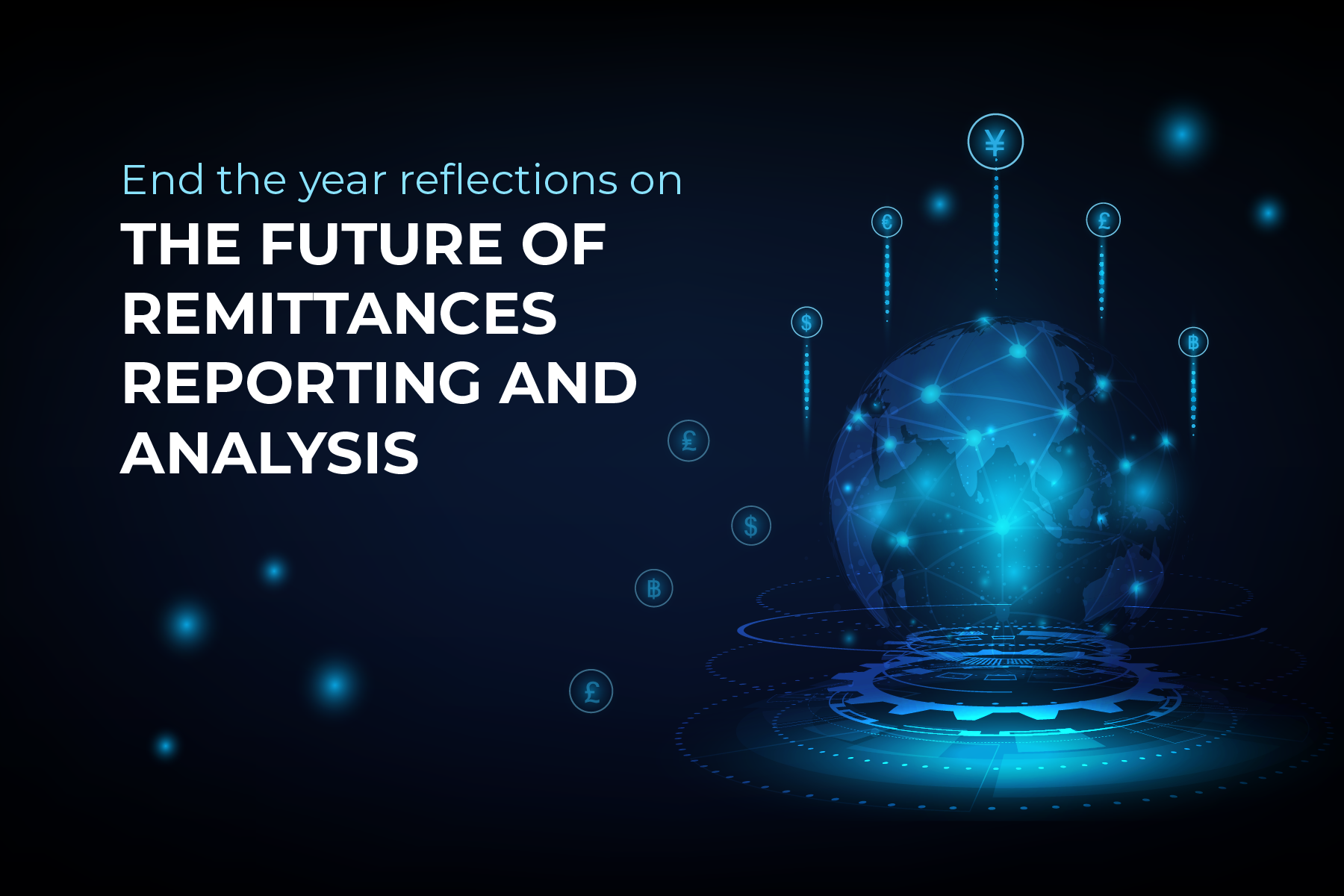
End of the year reflections on the future of remittances reporting and analysis
At the end of a year filled with opportunities, achievements, and challenges, United Nations Capital Development Fund (UNCDF) Remittance Policy Specialist Paloma Monroy and GVG Technical Director Laurent Sarr reflect on remittances and the future of remittances data collection and analysis.
How do you see the transition to granular remittance data?
Paloma Monroy: Ten years ago, regulatory and supervisory authorities could not have anticipated that granular data would become a key resource and that they would be collecting it to carry out more comprehensive and in-depth analyses. Today transaction-level data is a vital tool in the supervision of financial services, the setting of responsive economic and monetary policy, and providing the raw material to generate insights for the private sector to develop and target more appropriate, gender-smart products and services.
“There is a paradigm shift that central banking statistics are currently undergoing: the move from macro to micro statistics, or from aggregate to granular statistics, if you like.” (Sabine Lautenschläger, member of the Executive Board of the ECB and Vice-Chair of the Supervisory Board of the Single Supervisory Mechanism, at the Eighth ECB Statistics Conference, Frankfurt am Main, 5 July 2016),
This paradigm shift is fundamental to the rapidly changing, economically vital, and socially complex world of remittances. Worldwide, officially recorded international migrant remittances are projected to reach US$794 billion in 2022, with $626 billion flowing to low and middle-income countries. UNCDF has consulted with more than 70 central banks, and the demand for more granular information is clear. The economical importance, speed of technical innovation, the complexity of cross-border transfers, and the highly gendered nature of international remittances make it vital that public and private decision-makers start exploiting the ever-increasing volume of data generated by an industry fully embracing digitization. Central banks will play a critical role as the managers and custodians of this data. In many economies where remittances are economically vital, central banks face technical and budget challenges, which present significant challenges to implementing comprehensive data collection and analysis systems. However, since the start of the COVID-19 pandemic and the widespread recognition of the importance of remittances to many economies, many central banks have started to explore options to invest in systems to generate data and insights to support better policy and private sector decision-making around remittances.
The implementation of transaction-level remittance data collection for central banks is a reality in countries such as South Africa, Rwanda, the Dominican Republic, and Suriname, and it is an ongoing initiative in the Philippines or Ghana. We expect that more central banks will be collecting remittance data in the next decade at the transaction level. UNCDF has been developing a benchmarking tool to be released in 2023 to help countries find, compare, and share the means and systems for analysing remittance flows that could help them develop better policies based on ongoing consultations with more than 70 stakeholders worldwide, including central banks, national statistics offices, (NSOs), technology providers, and field practitioners. Specifically, on granular data, only 37 percent of the 70 central banks consulted report receiving transactional level data.
What technological developments in the last ten years have made transaction-level reporting a viable option now when, just a few years ago, it would have seemed like science fiction?
Laurent Sarr: Technology has never ceased to surprise us, even more so in the last ten years, which is practically when the most important technological advances and social changes have occurred. Whenever something new appears in any sector, we must restructure our schemes and adapt quickly as a society. Technological resilience is also necessary for any company today, but even more so if your business is in a developing country, as these nations need to be on the wheel of digital and technological transformation not to lose their pace of development.
The telecoms sector has primarily led this phenomenon of constant innovation with the transition from landline to mobile, smartphone penetration, and the rise of data/internet connectivity. Data has become the gold of the 21st century, and any technological development that facilitates data mining or processing will have a major impact on almost every sector, including remittances, which could even reshape the economy of a country or continent.
The Financial Action Task Force (FATF) strongly recommends that the Money Laundering and the Financing of Terrorism (ML/FT) risks, explicitly related to wire transfers, including remittances, be mitigated through a Customer Due Diligence (CDD) process involving the verification of the senders’ and the recipients’ identity and the adequate supervision of money transfer operators and the set limits on loading value and use. However, remittances are notoriously difficult to trace, especially if they are sent abroad and carried out through service providers that are not subject to, or do not comply with, the anti-money laundering (AML)/Combatting the financing of terrorism (CFT) rules in force. Most African governments, for instance, do not possess the resources to gather the data necessary to monitor the remittance ecosystem as per the FATF’s recommendations.
Transaction-level reporting technologies are therefore necessary. They should aim to achieve compliance with a complete lifecycle regulatory reporting management service using standardized data control, exception management, audits and reporting processes. Innovative AML/CFT technologies can help identify risks and focus compliance efforts on existing and emerging challenges when used responsibly and proportionally.
Obtaining accurate, reliable data for compliance verification and mitigating ML/FT risks on remittance markets would most likely require technology capable of automatically collecting this data from the source. These data would subsequently be made available in a usable format to governments, financial intelligence services, and other relevant authorities to help them in their analyses and investigations and thereby better inform their decision-making. Such a solution should also detect suspicious transactions that may point towards money laundering activities based on a set of rules established by the authorities and aligned with the best international AML practices and standards.
If left unsupervised, the remittance market is vulnerable to risks that may create serious security issues for developed and developing countries. As highlighted above, effective supervision is key to mitigating these risks. Big Data solutions can offer the required level of granularity by collecting, processing, and reporting on vast amounts of data produced by the remittance markets.
What role do data analytics play in a transaction-level data reporting system?
Paloma Monroy: UNCDF engages with public and private sector stakeholders to enhance the capacity of regulators and partners to monitor and analyse remittance transaction data, which can be used in evidence-based policymaking. UNCDF also works to foster risk-based policy and regulatory environments and to deliver financial and technical assistance to a wide range of financial institutions (e.g., banks, cooperatives, microfinance institutions, money transfer operators, and mobile network operators) to improve the digital remittance ecosystem and design migrant-centric, gender smart financial products and services (e.g., savings, credit, insurance, payment services, pensions, and investments).
Monitoring and analysing more detailed transaction data enables regulators and service providers to closely monitor the impacts of external shocks such as a banking crisis, conflicts, earthquakes, or, in this case, how the COVID-19 pandemic affected the market. One example shows that COVID-19 has accelerated the shift from remittances in cash to digital. We see that in 2019 in Bangladesh, only one in four remittances were sent through digital channels. This flipped in Q1 2020 because of the COVID-19 lockdown. Suddenly three in four remittance transfers were done digitally via banks and e-wallets. Digging deeper, we found other issues; some corridors, such as Singapore-Bangladesh, were more digitized than others, such as Malaysia-Bangladesh.
Moreover, women remittance recipients were less likely to use digital remittance channels, with only three in ten digital remittance recipients being women, compared to six in ten remittance recipients in the market. So, there is a risk that the shift from cash to digital leaves women, but also other last-mile customers, behind. Remittance data talks. The big question for the industry is whether this unexpected but welcome digital boost will remain after the crisis. The real test will come when the worst of the crisis has passed. Whether the changes stick will depend on the user experience that digital remittance services deliver right to their new and, perhaps in some cases, reluctant customers.
For these insights to inform the market, regulators must capture transaction-level data and have the systems and personnel to turn data into insights. This involves lowering the barriers to insight generation through data visualization tools and ensuring that strategists, product developers, researchers, and policymakers have access to these tools to generate insights to drive the market. Remittance data talks, but only when it is free to tell its stories.
Lauren Sarr: GVG provides clients with actionable information on each remittance transaction through live dashboards and unique functionalities.
The big data analytics market is set to reach $103 billion by 2023. In an increasingly fast-paced, complex, and digitized society, public administrations must develop policies that address problems efficiently. To achieve this, data analytics and business intelligence powered by technology such as GVG’s platforms enable users to capture the benefits of data sources to create improved policies.
Big data signifies a shift in the quality, quantity, and type of data that public administrations collect, with implications for the entire policy lifecycle. Regarding transaction-level data reporting, Business Intelligence Modules should include analytical tools to secure a specific ecosystem and encourage its growth, favouring transparent and accurate reporting systems that provide reliable business intelligence and data analysis.
Technology can turn raw data into actionable data by extracting it from relevant sources and analysing it according to clear objectives and measurable processes, providing objective and reliable information that can be trusted to guide policymaking and decision-making toward the people and planet’s goals entrenched in the 17 SDGs.

Paloma Monroy
UNCDF Remittance Policy Specialist

Laurent Sarr
GVG Technical Director
*This blog may contain advice, opinions, and statements from various content providers. United Nations Capital Development Fund (UNCDF) does not represent or endorse the accuracy or reliability of any advice, opinion, statement, or other information provided by any content provider or any user of this site or other person or entity.
